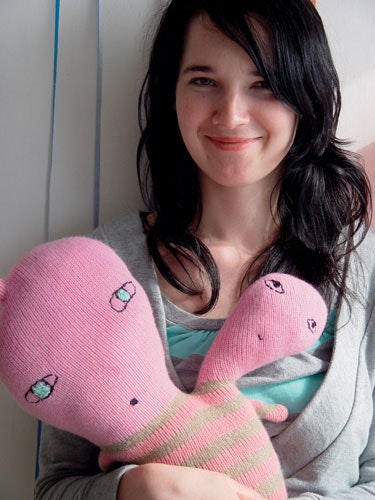Amid the trademark tasteful charcoal greys and elegant curves of the collection launched by contemporary British furniture brand SCP in Milan last month, one glowing, Technicolor item stood out, rather like an aberrant flash of Benetton in a Cecil Gee suit shop.
The designer responsible has been quietly making her name in British design circles for the past four years, despite having a slightly unconventional pedigree. Donna Wilson is a textile designer, but one who eschews the pull towards the textile or fashion industry that most of her Royal College of Art peers have gravitated towards, since graduating with an MA in Mixed Media (Constructed Textiles) in 2003. Instead, Wilson has carved herself a niche as a 3D designer working with knit, producing a growing brood of grotesque dolls, alongside graphic patterned cushions and rugs, sold through agents such as SCP, Thorsten van Elten and Liberty.
What characterises Wilson’s work is the strong thread of personality that separates her from the traditional vein. ‘I never wanted to make dolls that were cutesy,’ she says. ‘They gradually became creepier as I was thinking about Siamese twins, and watching documentaries about human deformities.’ The dolls have twisted, swollen heads, overstretched arms and frightening offspring emerging from their bellies. ‘I wanted people to feel sorry for these odd creatures and want to adopt them.’
Many of Wilson’s customers are graphic designers, who are drawn to the very stylised personalities of these creatures that bear a resemblance to contemporary animation. Her work wouldn’t look out of place in Playlounge, the Soho store for cult Japanese toys for grown-ups. Indeed, one of her main customers is Trico, a Japanese retailer for which she created an installation in August 2006 in Tokyo.
Wilson certainly plays on her ability to interrelate with the aesthetics of other design disciplines, with a hand-drawn animated website, designed by Marcia Mihotich, which also incorporates a movie clip of her dolls engaged in a cancan dance, produced by Max Alexander. MTV also commissioned a range of creatures to use in an animated ident for the programme Love is Blind, in January 2006. ‘My work is quite experimental and playful, and I want to stay in that sphere,’ Wilson says.
The commercial success of the creatures has subsidised Wilson’s continuing experimental work. She set up her own studio in south London after college with the help of a financial grant from the Crafts Council, and now employs an assistant, as well as an outworker in Orkney, and extra help at busy times in the retail calendar. Her order book is at the stage where she is considering taking the tricky step from being a designer-maker to engaging a small factory in England, but, she says, ‘I’ll still have to do the hand-finishing myself.’
So this first foray into furniture production, with the commission from SCP to design Motley, a knitted wool-upholstered footstool in the style of a Chesterfield sofa with the tonal subtlety of a hot-air balloon, marks a significant step. ‘Sheridan [Coakley] has always been a good customer for my work, and I think he likes the fact I take risks,’ says Wilson. ‘When he approached me about doing a piece for Milan, I knew I had to do something with wool.’ Wilson worked with SCP development manager Tim Cox at the factory, and machine-knitted the diamonds of upholstery herself. ‘It’s not a very commercial piece, as just fixing all 168 buttons takes seven hours. But I’d like to do a more saleable version.’
Wilson’s work became popular around the time that a big cultural revival of knitting began in 2004. Collectives such as the Cast-Off Club organised public activities, celebrities hopped on the bandwagon, and exhibitions such as Knit 2 Together at the Crafts Council, which grasped the cultural moment and became one of its most well-attended shows, brought these makers to a wider audience. Showing her ability to work in 3D, Wilson designed and knitted an entire woodland picnic installation to showcase her creatures.
While this mainstream reappraisal of knitting has no doubt boosted Wilson’s career, she points out that her work, being machine-produced, is set slightly apart from the hand-knitting revival. And while those people were playing on the faded popularity of knitting, she says that, for her, ‘It wasn’t a case of intentionally trying to revive an old concept. At college everyone is taught how to knit, and I’ve always liked the fact that it’s so instant that you can get quick results.’
Donna Wilson is exhibiting at The Scottish Show, The Lighthouse, 11 Mitchell Lane, Glasgow G1 3NU until 12 August
All pictured designs by Donna Wilson

- Brands in this article







